Class 1 - Explosives |

** Place for Division
* Compatibility Group
|
1.1 - A substance or article with a mass explosion hazard.
1.2 - A substance or article with a fragment projection hazard, but not a mass explosion
hazard.
1.3 - A substance or article which has a fire hazard along with either a minor blast hazard
or a minor projection hazard or both, but not a mass explosion hazard.
|
 |
1.4 - A substance or article which presents no significant hazard; explosion effects are
largely confined to the package and no projection or fragments of appreciable size or
range are to be expected.
|
 |
1.5 - A very insensitive substance which nevertheless has a mass explosion hazard like
those substances in 1.1.
|
 |
1.6 - An extremely insensitive substance which does not have a mass explosion hazard.
Commonly used in mining and construction operations (example: blasting agents).
|
Class 2 - Gases
|

|
2.1 - Flammable Gas.
Commonly used as fuel (example: propane).
|

|
2.2 - Non-Flammable, Non-Toxic Gas.
Commonly used in food refrigeration (example: nitrogen).
|

|
2.3 - Toxic Gas.
Commonly used in pulp bleaching (example: sulphur dioxide).
|
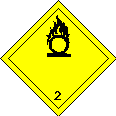
|
2.2 (5.1) - Oxygen and oxidizing gases.
|
Class 3 - Flammable Liquids
|

|
A liquid which has a closed-cup flash point not greater than 60.5oC.
Commonly used as fuel (example: gasoline, ethanol, fuel oil (diesel)).
|
Class 4 - Flammable Solids, Substances liable to spontaneous
combustion; Substances that on contact with water emit flammable
gases (water-reactive substances)
|

|
4.1 - A solid that under normal conditions of transport is readily combustible, or would
cause or contribute to fire through friction or from heat retained from manufacturing or
processing, or is a self-reactive substance that is liable to undergo a strongly exothermic
reaction, or is a desensitized explosive that is liable to explode if they are not diluted
sufficiently to suppress their explosive properties.
Commonly used in lacquers (example: nitrocellulose).
|

|
4.2 - A substance liable to spontaneous combustion, under normal conditions of transport,
or when in contact with air, liable to spontaneous heating to the point where it ignites.
Commonly used in rocket fuel (example: diethylzinc).
|

|
4.3 - A substance that, on contact with water, emits dangerous quantities of flammable
gases or becomes spontaneously combustible on contact with water or water vapour.
Commonly used in heat exchangers (valves) (example: sodium).
|
Class 5 - Oxidizing Substances and Organic Peroxides
|
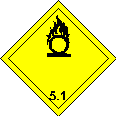
|
5.1 -A substance which causes or contributes to the combustion of other material by
yielding oxygen or other oxidizing substances whether or not the substance itself is
combustible.
Commonly used in fertilizers (example: ammonium nitrate).
|

|
5.2 -An organic compound that contains the bivalent "-O-O-" structure which is a strong
oxidizing agent and may be liable to explosive decomposition, be sensitive to heat, shock
or friction, react dangerously with other dangerous goods or may cause damage to the
eyes.
Commonly used in automobile body shops as body filler (example: dibenzoyl peroxide).
|
Class 6 -Toxic Substances and Infectious Substances
|
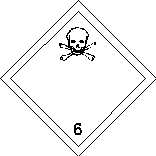
|
6.1 - A solid or liquid that is toxic through inhalation, by skin contact or by ingestion.
Commonly used as a germicide or general disinfectant (example: phenol).
|
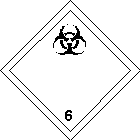
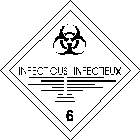 Label Label
|
6.2 - Micro-organisms that are infectious or that are reasonably believed to be
infectious to humans or animals.
Commonly used in disease research (example: rabies).
|
Class 7 - Radioactive Materials
|

 Label Label
 Label Label
 Label Label
|
Radioactive materials within the meaning of the Nuclear Safety and Control Act with
activity greater than 70 kBq/ kg.
Commonly used in nuclear fuel rods (example: radioactive material - LSA (yellow
cake)).
There are three categories which indicate the surface radiation level for a package
with Category I being the lowest level and Category III the highest.
|
Class 8 - Corrosives
|
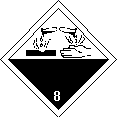
|
A substance that causes destruction of skin or corrodes steel or non-clad aluminum.
Commonly used in batteries and industrial cleaners (example: sulphuric acid and
sodium hydroxide).
|
Class 9 - Miscellaneous Products, Substances or Organisms
|

|
A substance that does not meet the criteria for inclusion in Classes 1 to 8. This
includes genetically modified micro-organisms, marine pollutants, elevated
temperature materials and environmentally hazardous substances.
Commonly used in brake shoes (example: asbestos), in dry cell batteries (example:
ammonium chloride).
|

